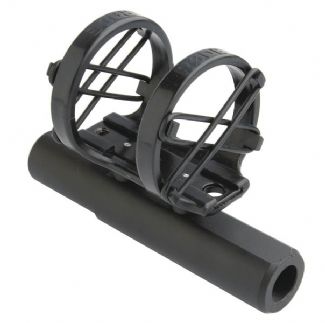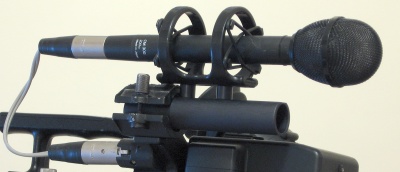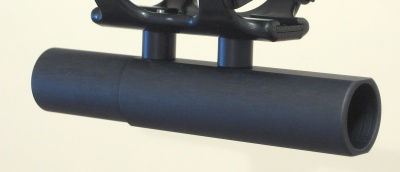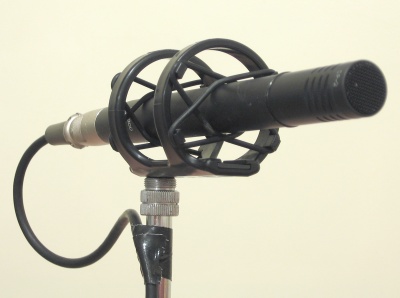
After several years of putting up with camera and tripod handling noises getting recorded, or fiddling around with home-made microphone shockmounts to avoid it (the last shockmount that I built worked rather well, but mysteriously disappeared, and professionally-built ones weren't cheap), I decided to try out a cheap pre-built unit. A little bit of searching around on the internet found something reasonably cheaply priced $50 for the mount, plus $10 postage), available locally, and wasn't designed just for specific microphones.
Since I have some moderately old, and very good, Nakamichi microphones that I couldn't buy accessories for anymore, and they're a different diameter than most other microphones (so I can't use many of the accessories built for other specific microphones, which tend to cost too much, anyway), and I wanted to avoid using the hotshoe mount point on the camera, I needed something that could handle any cylindrical-shaped microphone, and be attachable using the existing microphone clamp on the camera. The SM5 shockmount fitted the bill rather neatly.
The shockmount section is screwed to a very lightweight metal tube with two different diameters (24mm & 27mm) that should fit into many camera's built-in microphone clamps. The suspension bands should fit any cylindrical microphone with a suitable diameter, and support reasonable microphone weights.
The good points:
-
It's cheap, generic, simple, and came with a spare set of mounting bands.
-
You can remove the cylinder and then attach the shockmount on the end of a boom using the 1/4″ or and 3/8″ screw threads, which tap into in a metal plate.
The bad points:
-
It's described as a shotgun mount, but I don't think that the rings are spaced far enough apart to handle the length and weight of a shotgun microphone.
-
To use the mount on a pole, you'd have to use a screwdriver to remove the bottom cylinder, and all of the screw threads tap into a relatively thin metal plate (there's around two or three turns of thread), it's fiddly to re-assemble, and there's no pivot point.
-
The hollow tube might make noises when wind blows across it.
-
The rings are only made of plastic, so you'll need to take care of it.
-
The suspension bands are, perhaps, a little too taught for the weight of my microphone, providing less isolation than I might have hoped for. And mine dried out and cracked, terribly, about a year after I bought the shockmount. Likewise with the replacement, and the microphone is mostly used indoors, so it hasn't been exposed to harsh weather.
-
The suspension bands don't have enough of a grip along the shaft of a heavy microphone to stop a microphone from sliding out if it's tilted down too far, such as when pointing a microphone down from an overhead boom pole. Other shockmounts work by clamping a fixed part onto the microphone, and the suspension bands weave between the microphone clamp and an outer cradle.
In defence of the bad points:
-
You probably don't want to mount a long shotgun mike on a camera.
-
At this price, you'd buy another shockmount to put on your boom or floorstand (they make other versions of the shockmount that are made for mounting on poles and hotshoe fittings, and both of those do include a pivot point).
-
You can always stuff something into the hollow section (maybe it's the perfect place to stash your lens cloth?).
-
If you've put a $600 mike on a $20,000 camera, you are going to take good care while handling them.
-
You can always replace the bands with something else, to change the tension, or string them up in a different pattern. Your microphone might weigh more than mine does. And it's still better than a rigid mount. It came with a set of spare suspension bands, though you should probably buy one or two more sets, but I'd be inclined to find some alternative ones made out of a different material.
Having built my own shockmounts in the past, I know that getting the right amount of tension is a tricky thing. Too little, and your microphone sags, slips out, bounces back and forth, or floats about too freely. Too much, and it doesn't work as an isolating shockmount. That's why many microphones come with their own specially built shockmounts, they're designed as a whole unit. If this's important to you, then you spend the extra money on the more expensive units.
On the whole, I think this device hits just about all the right spots. It's a reasonable compromise between the good and bad points, especially for the price, and allows you to get away with a camera mounted microphone for when you cannot use a separate microphone.
For further information, I'd recommend visiting their website: http://www.rodemic.com/
Written by Tim Seifert on 22 Apr 2008, and last updated on 01 Dec 2010.



